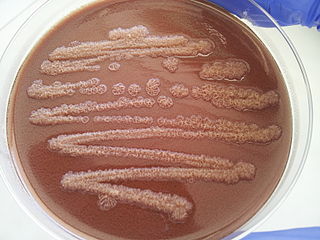
Arthrobacter is a genus of bacteria that is commonly found in soil. All species in this genus are Gram-positive obligate aerobes that are rods during exponential growth and cocci in their stationary phase. Arthrobacter have a distinctive method of cell division called "snapping division" or reversion in which the outer bacterial cell wall ruptures at a joint.

Pseudomonas stutzeri is a Gram-negative soil bacterium that is motile, has a single polar flagellum, and is classified as bacillus, or rod-shaped. While this bacterium was first isolated from human spinal fluid, it has since been found in many different environments due to its various characteristics and metabolic capabilities. P. stutzeri is an opportunistic pathogen in clinical settings, although infections are rare. Based on 16S rRNA analysis, this bacterium has been placed in the P. stutzeri group, to which it lends its name.
Delftia is a genus of Gram-negative bacteria that was first isolated from soil in Delft, Netherlands. The species is named after both the city, and in honor of pioneering research in the field of bacteriology that occurred in Delft. Cells in the genus Delftia are rod shaped and straight or slightly curved. Cells occur singly or in pairs, are 0.4–0.8ɥM wide and 2.5–4.1ɥM long. Delftia are motile by flagella, non-sporulating, and chemo-organotrophic.
Marinobacter hydrocarbonoclasticus is a species of Proteobacteria found in sea water which are able to degrade hydrocarbons. The cells are rod-shaped and motile by means of a single polar flagellum.
Gallaecimonas is a recently described genus of bacteria. The first described species of this genus was Gallaecimonas pentaromativorans gen. nov., sp. nov. isolated by Rodríguez Blanco et al. in 2010 from intertidal sediments of the ria of Corcubión. It is a Gram-negative, rod-shaped, halotolerant bacterium in the class Gammaproteobacteria. It can degrade high molecular mass polycyclic aromatic hydrocarbons of 4 and 5 rings. The 16S rRNA gene sequences of the type strain CEE_131(T) proved to be distantly related to those of Rheinheimera and Serratia. Its G+C content was 41.7 mol%.
Delftia lacustris is a Gram-negative, nonfermentative, motile, rod-shaped bacterium from the family Comamonadaceae, which was isolated from mesotrophic lake water in Denmark. It has the ability to degrade peptidoglycan through chitinase and lysozyme activity.
Cycloclasticus pugetii is a species of bacteria, named in honor of Peter Puget. It is found in marine sediments. It is notable for being an aromatic hydrocarbon-degrading bacteria. It is aerobic, gram-negative, rod-shaped and motile by means of single polar flagella. Strain PS-1 is its type strain.
Alcanivorax pacificus is a pyrene-degrading marine gammaprotobacterium. It is of the genus Alcanivorax, a group of marine bacteria known for degrading hydrocarbons. When originally proposed, the genus Alcanivorax comprised six distinguishable species. However, A. pacificus, a seventh strain, was isolated from deep sea sediments in the West Pacific Ocean by Shanghai Majorbio Bio-pharm Technology Co., Ltd. in 2011. A. pacificus’s ability to degrade hydrocarbons can be employed for cleaning up oil-contaminated oceans through bioremediation. The genomic differences present in this strain of Alcanivorax that distinguish it from the original consortium are important to understand to better utilize this bacteria for bioremediation.
Novosphingobium pentaromativorans is a species of high-molecular-mass polycyclic aromatic hydrocarbon-degrading bacterium. It is Gram-negative, yellow-pigmented and halophilic. With type strain US6-1T. Its genome has been sequenced.
Aurantiacibacter atlanticus is a Gram-negative, rod-shaped and motile bacteria from the genus Aurantiacibacter which has been isolated from deep-sea sediments from the Atlantic Ocean. Erythrobacter atlanticus has the ability to degrade polycyclic aromatic hydrocarbons.
Sphingomonas formosensis is a Gram-negative and short rod-shaped bacteria from the genus of Sphingomonas which has been isolated from agricultural soil in Kaohsiung County in Taiwan. Sphingomonas formosensis has the ability degrade polycyclic aromatic hydrocarbon compounds.
Sphingomonas polyaromaticivorans is a Gram-negative, aerobic, short-rod-shaped and non-motile bacteria from the genus of Sphingomonas which has been isolated from water from the Botan Oil Port in Xiamen in China. Sphingomonas polyaromaticivorans has the ability to degrade hydrocarbon compounds.
Marinobacter aromaticivorans is a Gram-negative, rod-shaped and slightly halotolerant bacterium from the genus of Marinobacter which has been isolated from sediments from the South China Sea. Marinobacter aromaticivorans has the ability to degrade polycyclic aromatic hydrocarbons.
Novosphingobium indicum is a bacterium from the genus Novosphingobium which has been isolated from deep-sea water from the Indian Ocean. Novosphingobium indicum hasd the ability to degrade polycyclic aromatic hydrocarbon.
Brachybacterium fresconis is a species of Gram positive, strictly aerobic, cream-pigmented bacterium. The cells are coccoid during the stationary phase, and irregular rods during the exponential phase. It was first isolated from a medieval wall painting of the chapel of Schloss Herberstein in Styria, Austria. The species was proposed in 2014, and the name is derived from the fact it was first isolated from a fresco.
Stenotrophomonas acidaminiphila is a strictly aerobic, Gram-negative, mesophilic, non-spore-forming and motile bacterium from the genus of Stenotrophomonas which has been isolated from industrial waste water in Mexico. Stenotrophomonas acidaminiphila can degrade polycyclic aromatic hydrocarbons.
Celeribacter halophilus is a Gram-negative and non-motile bacterium from the genus of Celeribacter which has been isolated from seawater from the coastal region of Qingdao in China.
Tropicibacter naphthalenivorans is a Gram-negative, aerobic and motile bacterium from the genus of Tropicibacter which has been isolated from seawater from the Semarang Port in Indonesia.
Zobellella maritima is a Gram-negative, aerobic, rod-shaped and motile bacterium from the genus of Zobellella which has been isolated from the beach of Sinduri in Korea. Zobellella maritima is able to degrade polycyclic aromatic hydrocarbons.
Oceanimonas marisflavi is a Gram-negative, strictly aerobic, rod-shaped and motile bacterium from the genus of Oceanimonas. Oceanimonas marisflavi is able to degrade polycyclic aromatic hydrocarbons.

